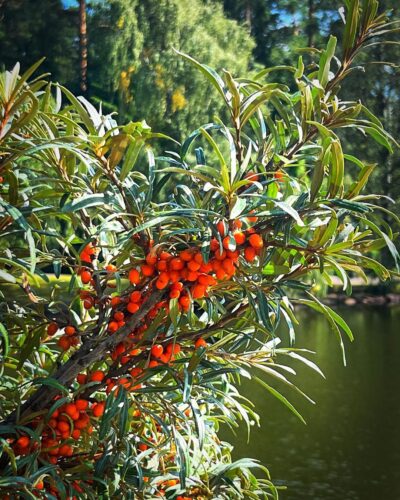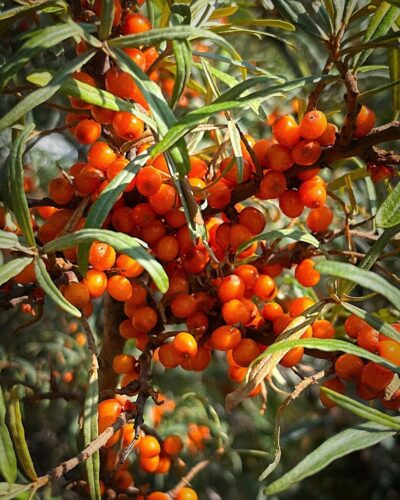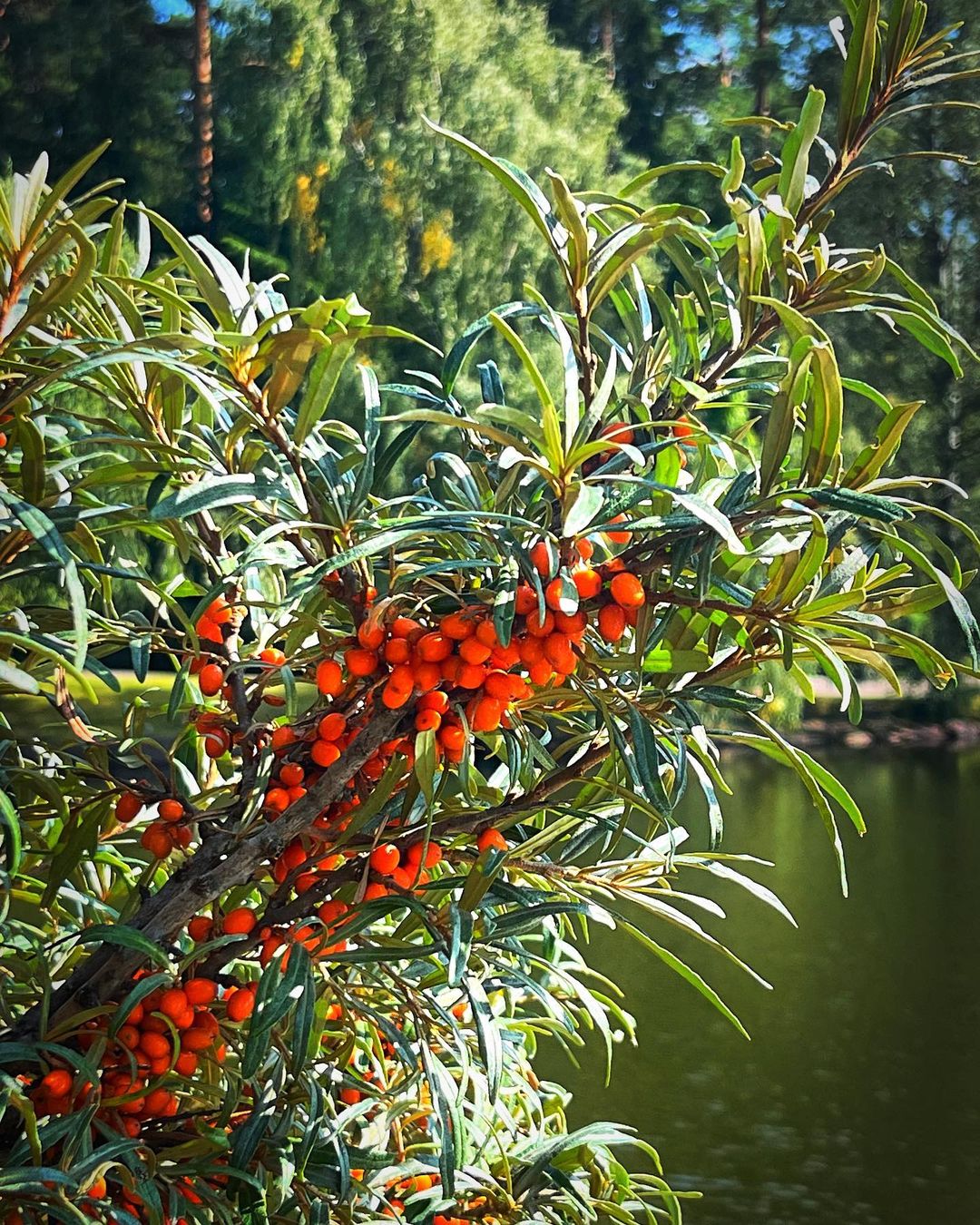Sea Buckthorn can be an interesting addition to your garden as this shrub offers beautiful berries with many uses.
If you want to include a shrub in your garden with exceptionally useful berries, then Sea Buckthorn is an excellent option for you. Read the details below.
Read: Rudraksha Tree Care
What is Sea Buckthorn?

Also known as Seaberry, Siberian pineapple, Sandthorn, and Swallow Thorn, Sea buckthorn (Hippophae rhamnoides) is a member of the Elaeagnaceae family. It is a willow-like shrub that can reach up to 8 feet in height.
The natural range of this plant extends from northwestern Europe to central Asia, including the Altai Mountains. Also, it covers parts of western and northern China as well as the northern Himalayas.
This shrub has narrow leaves with a silvery underside and produces round, orange-yellow fruits that are about 1/3 inch in diameter. Seaberry is commonly found on sand dunes along the eastern and southeastern coasts of Great Britain, as well as in the mountains of Europe and Asia. Sea buckthorn is often grown for its attractive fruits and foliage as an ornamental plant. Flowers appear subtly between March and May, differing from the striking appearance of the plant.
Being dioecious, each sea buckthorn plant has either male or female flowers. To produce berries, the female plant requires nearby male pollination.
Read: ‘Grey Owl’ Juniper Care
Sea Buckthorn Varieties
Cultivated varieties of sea buckthorn are available for gardens, but male and female plants are sold separately. As the plant is dioecious, choosing the right combination is crucial. Here’s a list of the best Sea Buckthorn varieties for your garden.
For Optimal Pollination
It is advisable to plant male sea buckthorn in a location where the wind can carry its pollen toward the female plants. However, some sea buckthorn varieties, such as the ‘Friesdorfer Orange,’ have been selectively bred to be self-pollinating and do not require this arrangement.
Note: Nevertheless, it’s worth noting that self-pollinating varieties tend to produce a relatively lower yield of fruits.
Read: Pacific Sunset Maple Tree Care
How to Propagate Sea Buckthorn
Sea buckthorn propagation is easy – the real challenge is to prevent their growth. The runners of the plant spread rapidly through any garden and, if not controlled, can form dense hedges.
1. Propagate through Runners
The simplest method is to utilize the runners. If they are growing in the desired direction, you can allow them to continue growing. However, if necessary, you can trim the rooted runners, ensuring that you leave as much of the root as possible intact. These trimmed runners can then be replanted in a new location of your choice.
2. Through Low-hanging Branches
- The best shoot to use for propagating a sea buckthorn plant is one that is growing near the ground and on the outer edge of the shrub.
- First, create a narrow hole in the ground and carefully place the shoot inside it.
- Cover the shoot with soil, leaving only the tip visible. To secure the branch, use stones to cover the hole, taking care not to damage the branch.
- When roots develop at the base of the branch, a new plant will form.
- You can choose to leave the newly rooted branch where it is or transplant it the following year.
3. From Cuttings
- During the winter season, cut a strong, year-old shoot from the center of the shrub, which should be around 6 to 8 inches long or two buds in length.
- Use loose, low-nutrient potting soil to promote efficient root growth.
- Only the top third of the cutting should be visible when planted in a pot.
- Place the cuttings in a cool, frost-free, shady, and wind-protected area, ensuring the soil is never completely dry but also avoiding waterlogging.
- Wait for about three weeks after the cutting begins to sprout before planting in the garden.
Note: It is important to note that cuttings are more difficult to propagate than runners or shoots, and not all cuttings may result in a plant, so it is recommended to use several cuttings to increase the chances of success.
4. Growing Sea Buckthorn from Seed
Seed Germination: After stratification to break dormancy, sea buckthorn seeds typically germinate within 3 to 10 days, depending on the temperature. For optimal germination when sown in the spring or in a greenhouse, it is recommended to stratify the seeds for 90 days at 37 to 41 F under moist conditions.
Planting Seeds: To grow the plants, scarify the seeds with sandpaper, then sow them outdoors in fall or spring, or store them moist in the refrigerator for 30 to 90 days and plant them indoors with high-quality compost. Keep the seedlings watered and free of weeds. Transplant to bigger pots until ready for outdoor planting.
Tip: Scarify seeds by rubbing them on sandpaper to simulate bird digestion and promote germination.
Points to Consider Before Planting Sea Buckthorn Seedlings:
Planting inexpensive seedlings may seem like a good idea, but keep in mind that seedlings are essentially wild plants. This means they will grow extremely vigorous root systems that tend to aggressively produce root suckers, which can easily turn into a wild thicket of thorns. To keep their self-propagation under control, you will need to mow regularly around the base of each tree. Also, read the below points;
- Seedlings take around six years to start producing fruit, and it will be impossible to determine if they are male or female plants during this time.
- Sea Buckthorn seedlings are wild and have roughly 30% genetic difference from their parent plant. This means you won’t know what type of seaberry you’ll end up with.
- Furthermore, sea buckthorn grown from seed are typically very thorny plants, and their fruits are often very sour with many stellate hairs, making them less tasty for eating or baking purposes.
Note: With remarkable tolerance to drought and saline conditions, this plant can thrive in USDA zone 3 and beyond.
Read: Ice Cream Bean Tree Care
Growing Sea Buckthorn in a Pot
- Sea buckthorns can survive in pots for a few years despite thriving in open areas. To grow this shrub in a pot, use a container that is at least 24 inches wide. Make sure to repot regularly into larger containers when possible.
- A suitable planting mix is a citrus plant-soil blend with approximately one-third of sand and expanded clay.
It is also recommended to occasionally apply fertilizer to provide the plant with a continuous supply of nutrients. - Additionally, it is beneficial to replace the soil every few years to replenish the nutrient supply.
However, it is essential to note that these shrubs require much more space than a pot can provide. It will only thrive well when planted in the ground.
Read: Fireglow Japanese Maple Care
Ideal Growing Conditions for Sea Buckthorn

Plant Sea Buckthorn between October and November or in late February.
Location
Sufficient sunlight is essential for the growth of sea buckthorn plants. They require abundant light to flourish, and the absence of it can result in the failure of female sea buckthorns to produce fruits. A location that is well-lit and free from shade by other trees is ideal for their growth.
Soil
This shrub grows well in sandy soils that are slightly acidic or alkaline. If planting in heavy soils, it is recommended to mix in at least one-third sand to improve aeration. The amount of sand required may vary depending on the texture of the soil; lighter soils may require less sand.
Alternatively, if your garden already has very sandy soil, consider mixing in potting soil in a 1:1 ratio to improve yields. When selecting a compost, choose one that is high in phosphorus but not excessively high in nitrogen.
Water
Sea buckthorn is exceptionally resilient to drought, and as such, it doesn’t require regular watering using a watering can or garden hose. The only exception to this is potted sea buckthorn, which may require occasional watering during hot summers since the soil in pots tends to dry out quickly.
However, caution should be exercised to prevent overwatering, as sea buckthorn is vulnerable to waterlogging.
Spacing
Sea buckthorn is popular for its extensive and sprawling growth. To ensure adequate space for its growth, plant sea buckthorn at a minimum distance of ten feet from any other plant. This will enable the plant to flourish without any constraints from nearby plants.
Read: Tips to Grow River Tamarind
Sea Buckthorn Care
Fertilizer
This plant is not a heavy feeder, as it has the ability to meet its own nitrogen requirements and largely fertilizes itself.
However, when planting young sea buckthorns, it’s important to note that they do not fertilize themselves adequately. To give them a good start, it’s recommended to use a good potting compost or a slow-release fertilizer. Potted sea buckthorns require more frequent fertilization due to their limited soil and nutrient supply. If you can’t work the fertilizer into the surface, you can soak the pellets in water for a few hours, stir, and then pour them into the pot. Finally, cover the entire surface with a thin layer of bark mulch.
Pruning
It’s advisable to wear gloves while pruning sea buckthorn bushes. Prune them during late winter, before flowering starts. For female varieties, pruning is advisable every two years, while male varieties require pruning every three to four years. When pruning, cut back old shoots to the roots and avoid cutting young shoots. Pruning of male plants should be done cautiously, leaving old wood untouched.
If necessary, thinning can be done all year round.
Note: If you have multiple female plants, consider pruning them in alternating years to maximize your annual harvest.
Overwintering
Sea buckthorn is highly adaptable and can flourish in various climates, even withstanding temperatures as low as -45.4°F. However, it’s advised to keep young sea buckthorn in a greenhouse during their first winter before planting them outside.
Harvesting Sea Buckthorn Berries
Sea buckthorn berries typically ripen from September to October, with some varieties being ready as early as August. It’s best to pick berries when they are in their brightest color. While it’s possible to harvest berries in the spring, the early-season berries are usually less palatable. Animals often eat them before humans have a chance to pick them.
Harvesting sea buckthorn can be challenging due to its thorny nature, so it’s important to wear thick gloves to avoid injury. You can use a berry picker or a kitchen fork to push the berries off the branches. As the season progresses, the berries may be easily shaken off the branches and caught with a cloth. The attachment of the berries to the branch varies by variety.
Alternatively, you can cut the whole branches into small pieces and shock freezes them. This method can help you shake the berries off more easily later on.
Is Sea Buckthorn Poisonous?
Despite its prickly and thorny appearance, it’s worth noting that no part of the sea buckthorn shrub is toxic. In fact, berries are not only tasty but also highly nutritious and beneficial for health.
Is Sea Buckthorn Invasive?
The growth habit of sea buckthorn involves the formation of runners that can rapidly spread across extensive areas of the garden. To avoid it from dominating your garden, it’s recommended to implement a root barrier and periodically remove its shoots. This will help to control its growth and prevent it from overrunning the area.
Sea Buckthorn Uses
Sea buckthorn berries have a delightful sweet and sour flavor and are an excellent source of beta-carotene, as well as vitamins C, E, and B12. These berries have anti-inflammatory properties and are particularly effective at preventing colds and fevers. Drinking sea buckthorn juice regularly is also recommended for pregnant women as a healthy source of vitamins. In fact, these berries are considered a superfood due to their numerous health benefits.



